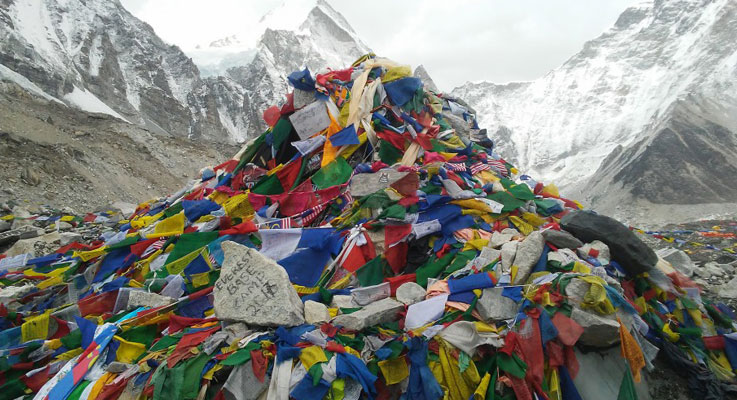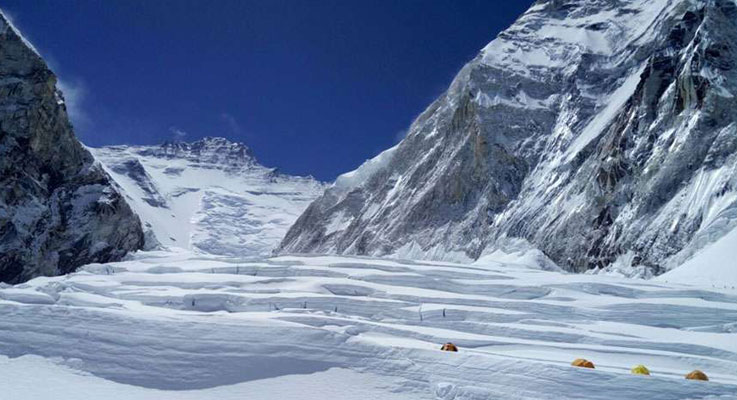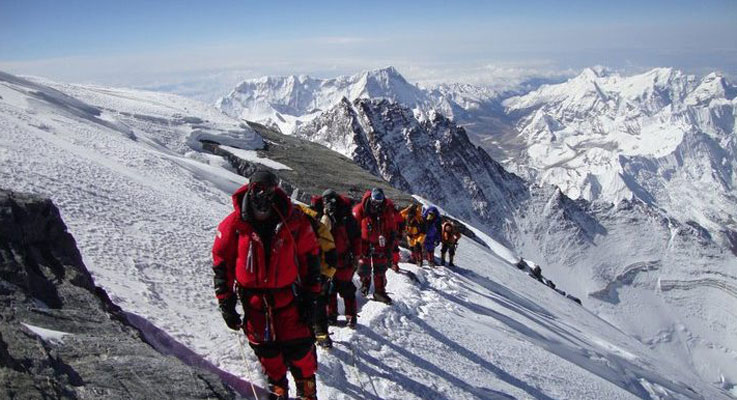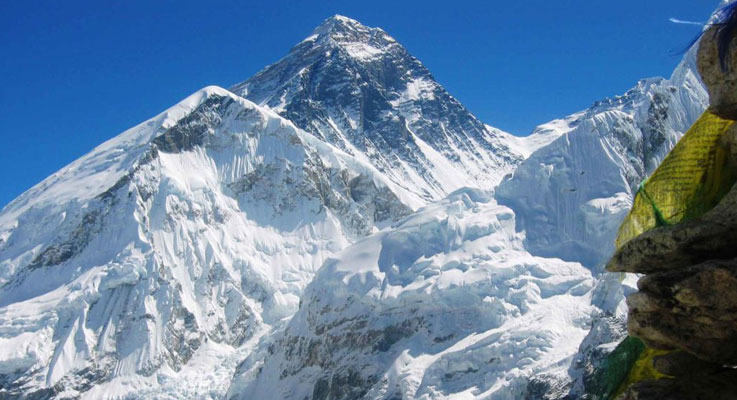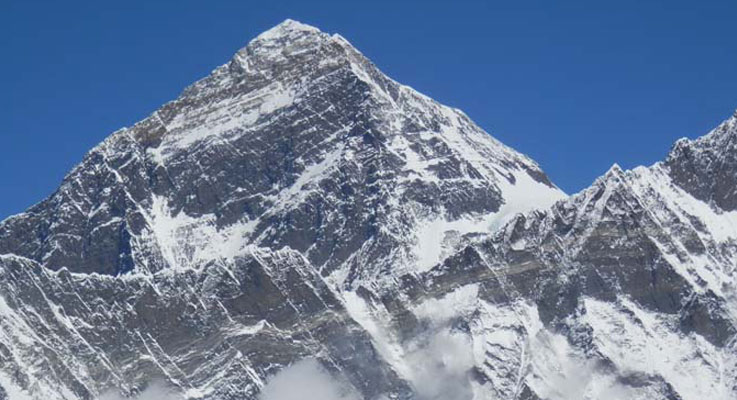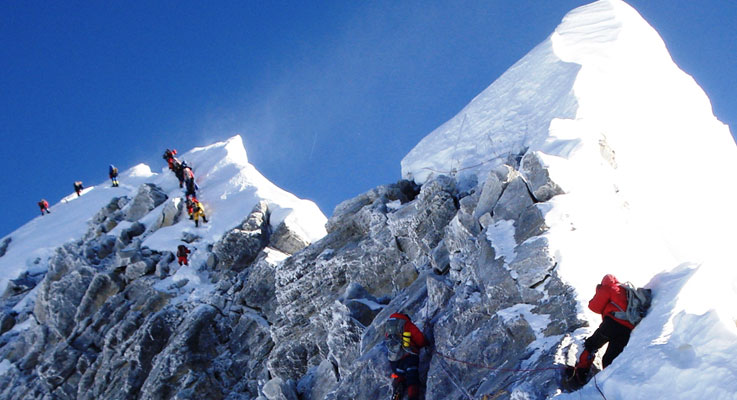Day 18-61
Climbing period from Base camp to Summit and Back to the Base Camp
Camp 1: 6400m (20,996ft).
The Camp 1 is situated on a horizontal area of deep snow sheltered by mountain walls. The area is warm due to sun’s reflection during the day, and at night the deep murmuring, cracking sounds of crevasses beneath the tents can be heard.
Camp 2: 6750m (22,145ft).
Camp 2 is set at the foot of the icy Lhotse wall. Expect cloudy but pleasant weather.
Camp 3: 7100m (23,292ft).
Camp 3, located adjacent to the Lhotse wall, is reached using fixed rope. The path takes us through the steep allow bands (lose, down-slopping, and rotten limestone). As we cross short a snowfield, the route takes us up the Geneva Spur to the east before coming to the flats of the South Col. Beyond Camp 3, some climbers may feel minor discomfort due to the altitude, and the use of oxygen may be necessary.
Camp 4: 8400m (27,560ft).
This is the last camp of the expedition and the riskiest section of the climb, just 450 meters from the summit. The narrow southeast ridge is taken to attain the south summits (8,750m), and from here it is easy to reach at Everest’s summit at 8,848 meters.
The Climb
From the base camp, the route to the summit can be divided into four separate sections: the Khumbu Icefall, the Western Cwm, the Lhotse Face and the Summit (southeast ridge).
The Khumbu Icefall
The Khumbu Icefall is found at the head of the Khumbu Glacier, 5,486m (18,000ft) high and not far above the base camp. Southwest of the summit, the icefall is regarded as one of the most dangerous stages of the South Col route to Everest's summit. The Khumbu Glacier forming the icefall moves at such speed that large crevasses open with little warning. The seracs (large towers of ice) found at the icefall have been known to collapse suddenly. Great blocks of ice tumble down the glacier from time to time, ranging from the size of cars to large houses. It is estimated that the glacier advances three to four feet (0.9m to 1.2m) down the mountain every day.
Since the structures are continually changing, crossing the Khumbu Icefall is extremely dangerous. Even extensive rope and ladder crossings do not always prevent loss of life. Many people have died in this area –one such climber was crushed by a twelve story block of solid ice. Exposed crevasses may be easy to avoid, but those buried under the snow can form treacherous snow bridges through which unwary climbers can fall. Extreme caution is urged at this stage of the expedition.
The Western Cwm
Walking into the Western Cwm is like entering the hall of the mountain gods. The gigantic walls of this awe-inspiring basin tower over you as we progress from Camp 1 toward the full expanse of the cwm above, with the west ridge of Everest to the left and the north face of Nuptse to the right. This is the narrowest section of the path, with gaping crevasses running across the relatively flat floor. These holes are so big that they are measured in terms of double-decker buses! Because of this, crossing them often requires stretching ladders stretched across. The crevasses add to the sense that, having passed through the labyrinth of the icefall, the gods have set one more task for you before reaching their inner sanctum. This final test usually includes at least one steep wall of ice, rising straight from the floor to produce a vertical step of about 30m (100ft), taking us up to the hallowed ground of the upper Western Cwm.
From here, with the gods gazing down from the mountain's upper ramparts, easy (but exhausting) progress is made to reach Camp 2, nestled below the west ridge just short of the foot of the southwest face.
The Lhotse Face
Early in the season, when the face is still unmarked by human progress, this steep section makes for the most grueling and technically intricate day on the mountain. Gusting winds, snow plumes, and the sight of the steep face looming above greet you at the base of Lhotse after a steady morning walk to the very end of the Cwm, above Camp 2. Careful footwork will have you ascending this section confidently, where the laser-straight ascent - rising on a slope that seems to touch your nose - is in stark contrast to the zigzag maze of the icefall below.
Arrival in Camp 3, halfway up the Lhotse Face, gives you a truly rugged, high mountain experience. Platforms cut just wide enough for the tents will have been hewn out of the thick ice by the Sherpas ahead of our arrival. Once that work has been done, it's a mass exodus of our Sherpas back down to the comforts below. The Sherpas play by Sagarmatha's rules, and for them a night on these exposed ledges is frowned upon by the mountain gods. Well, that's what they say, but since it only takes an hour or so to return below, and they can be ready for work before we climbers have even risen for breakfast, why wouldn't they take their rest lower down? For those with slower legs, we settle here on the ledge for one of the most glorious sunsets view seen by any human in all time (save the Apollo astronauts, perhaps!).
Typically, our camp is pitched in the lower neighborhood of Camp 3 (which can sprawl over several hundred meters up the slope), affording us better shelter from the winds than some of the tents perched above. After a night of re-hydration and an initial round of oxygen-rich sleep, we’ll return to the base camp and then all the way off the mountain to Dingboche. We’ll return here only once more, on the way to the summit.
When we next leave Camp 3 at 7,400m, you will be gripped by the first flush of true summit fever; down-suits donned, Top Out masks fitted, the first hiss of oxygen spreads from tent to tent as valves are cracked open. This marks the first day of climbing on "gas," and the first stage of your ascent into the "death zone."
The view does not disappoint either. The Nuptse Wall forms one half of the crescent bowl surrounding us, and the west shoulder of Everest the other. Down the valley, the towering peaks of Pumori and Lingtren, which rise with grandeur above the base camp, now look like insignificant ridges in the vast sea of Himalayan giants stretching out as far as the eye can see. The village of the base camp is long out of sight, now registered only by crackling radio transmissions during early morning calls.
The climb from Camp 3 launches another adrenaline-pumping attack on the senses as we inch up the steep Lhotse Face. Using an ascender on a fixed line, we grind up, slowly and steadily. After a grueling early morning, the effort is rewarded by a left turn across Lhotse toward the famous landmark of the Yellow Band. It's no small relief at this point, as you will have ascended some 1200m (3700ft) from Camp 2. When you look down the sweep of the Lhotse Face, our tents will appear as tiny dots, like peppercorns scattered at your feet.
The second section rears up and onto the rocky Geneva Spur, adding exciting scrambling to the mix. The exhilaration of scrambling in such a sensational setting, combined with the apprehension of approaching 8000m and the anxiety of catching your breath on top of the Spur while drawing heavily through the oxygen mask needs first-hand experience to comprehend. Turning the corner here, we’ll head across the home stretch to the highest camp at the South Col, on what seems to be flat ground. Now the fixed line disappears briefly, which lends an enticing sense of freedom, even though the wind usually picks up speed here, whispering caution. The last few meters of walking to the South Col inevitably brings with it a flood of emotions, since you've made all but the very last leap en route to the highest point on earth.
After a few moments of contemplation, it's down to business. Navigating toward the relative shelter of our tents, there’s an immediate dash to remove damp socks, arrange boots to dry, tie down crampons and ice axes outside, and dive into warm sleeping bags while setting to work on sparking up the stoves.
South Col to Summit
After an afternoon of rest and refreshment, as well as attempts to sleep (thwarted by excitement and adrenaline), the summit push begins between 10 p.m. and midnight. Typically the howling winds, which will accompany the team in the first hours of climbing, die down as the night continues.
We arrive at the small platform of snow known as the Balcony, where we change oxygen bottles, steal a few minutes rest, and make contact with the base camp, on standby maintaining a watchful vigil while we make for the top.
The route then turns to a sustained 300m (1000ft) climb up the southeast ridge toward the south summit. The climbing remains similar to the earlier sections: step, pause, breathe, and repeat. Passing across some rocky steps at the top of the ridge, we reach the south summit. From here the view opens up to the Hilary Step and all the way up to the top. Depending on whether we have changed oxygen bottles at the Balcony, we may switch again here.
Above the tangle of fixed lines on the 40 ft Hilary Step, it's about 100m (330ft) vertically between here and the summit. But the sheer drop down the Kangshung Face on one side and the southwest face on the other makes this section of breathtaking climbing both physically and emotionally hard. And the reward, of course, opens up at 8848m (29,028ft), where there's no higher step in the world.
We hope to be on the summit in the early morning, with plenty of time to make the long descent to the South Col. After spending another night sleeping with oxygen, the team will descend from Camp 4 on the South Col, directly to Camp 2 and then, the next day, to the base camp.

